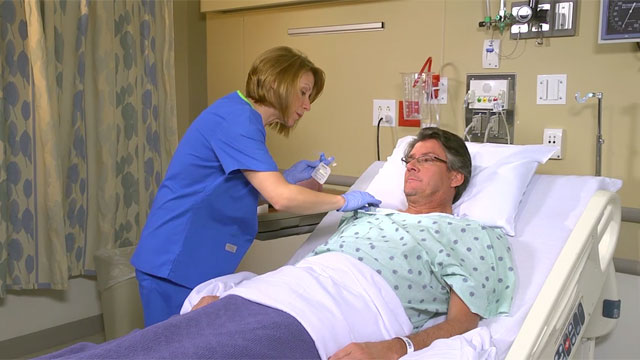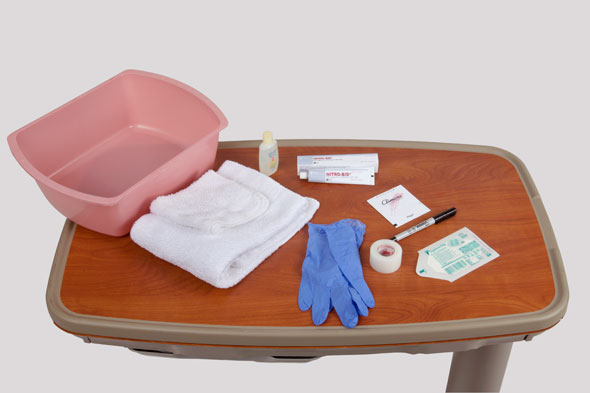Nonparenteral Medication Administration
Select a Skill:
- » Applying Topical Medications
- » Applying an Estrogen Patch and Nitroglycerin Ointment
- » Administering Eye Medications
- » Administering Ear Medications
- » Using a Metered-Dose Inhaler
- » Using a Dry Powder Inhaler
- » Inserting a Rectal Suppository
Take the Review Test:

Safety
- Be aware that topical medications may have systemic effects when absorbed through the skin or other tissue membranes and are more likely to occur when the skin is thin, drug concentration is high, contact with the skin is prolonged, or the drug is applied to non-intact skin.
- To protect yourself from accidental exposures, wear gloves when applying transdermal patches or nitroglycerin ointment.
- Avoid the application of heat, such as a heating pad, over transdermal patch or ointment. Heat could increase the rate of absorption with potentially serious adverse effects.
- Never apply an estrogen transdermal patch on or near breast tissue or waistline.
- Use soft-tip or felt-tip pen—not a ballpoint pen—to write the date and time on transdermal patches. Writing with a ballpoint may interfere with medication absorption
- For the safety of patients, other adults, pets, and children, instruct the patient to wrap used patches and place them into cardboard or plastic containers for disposal.
Equipment
(Roll cursor over items to see labels)

Clean gloves
Ordered medication - transdermal patch
Ordered medication - nitroglycerin ointment with application paper
Basin
Washcloth and towel
Nondrying soap
Transparent dressing (optional)
Tape (optional)
Felt-tip pen
Delegation
Administration of an estrogen transdermal patch or nitroglycerin ointment may not be delegated to nursing assistive personnel (NAP). Be sure to inform NAP of the following:
- Expected therapeutic effects, as well as any potential side effects that should be reported to the nurse.
Preparation
- Check the accuracy and completeness of the medication administration record (MAR) against the health care provider’s medication order.
- Note patient allergies.
- Read manufacturer’s application directions carefully.
- Observe the six rights of medication administration: right medication, right dose, right patient, right route, right time, and right documentation. (For details, see the video skill "Ensuring the Six Rights of Medication Administration.")
- Prepare medications for application. Check the medication's label against the MAR twice. Preparation usually involves taking the bottle, tube of lotion, cream, ointment or patch out of storage and to the patient's room. Check the expiration date.
Follow-up
- Ask the patient or family member to name the medication and state its action, purpose, dosage, schedule, and side effects.
- Have the patient keep a diary of medication doses and location of application sites.
- Observe the patient or caregiver applying the topical medication.
- Inspect the skin between applications noting redness, irritation, blisters, or oozing.
- Report patient response, side effects, and withheld doses to the health care provider.
- Discuss reasons for noncompliance and possible alternatives if the patient is unable to explain information about the drug or does not administer it as prescribed.
Documentation
- Document the condition of the skin before application of transdermal patch or ointment.
- Record the time of administration, type and strength of medication applied, and application site in the MAR immediately after administration, not before. For hard-copy documentation, include time and initials or signature per institutional policy.
- Record patient teaching and validation of the patient's understanding.
- Record the reason any medication is withheld, and follow facility policy for noting withheld doses.
- Record therapeutic response to medication as well as adverse effects.
Review Questions
1. Which statement best illustrates the nurse’s understanding of the role of nursing assistive personnel (NAP) in applying an estrogen patch?
 "Let me know when it's time to change the patient's patch."
"Let me know when it's time to change the patient's patch."  “Take care not to apply the patch over breast tissue."
“Take care not to apply the patch over breast tissue."  "Please apply lotion to the site from which the old patch was removed.”
"Please apply lotion to the site from which the old patch was removed.”  “Make a note of where the patch is now before you remove it.”
“Make a note of where the patch is now before you remove it.”
2. The nurse is preparing to apply an estrogen patch to a patient who will be discharged with a prescription for the medication. What would the nurse do to ensure the patient is able to apply the medication patch?
 Determine the patient's physical ability to grasp the patch
Determine the patient's physical ability to grasp the patch  Assess the patient's skin for appropriate application sites
Assess the patient's skin for appropriate application sites Assess the patient's understanding of the medication's purpose
Assess the patient's understanding of the medication's purpose Determine the patient's ability to recognize the medication's possible side effects
Determine the patient's ability to recognize the medication's possible side effects
3. Which statement best illustrates the nurse’s understanding of appropriate sites for the application of an estrogen patch?
 "I’ll check to see if the patient has pendulous breasts."
"I’ll check to see if the patient has pendulous breasts."  "I need to assess the skin on the patient's thighs."
"I need to assess the skin on the patient's thighs."  "I need to encourage her to wear elastic waistbands."
"I need to encourage her to wear elastic waistbands."  "I’ll tell her to wear blouses and shirts with loose sleeves.”
"I’ll tell her to wear blouses and shirts with loose sleeves.”
4. The nurse is preparing to discharge a patient after instructing her how to apply her own estrogen patch. What is the best way for the nurse to follow up?
 Tell the patient what the most common errors in application are
Tell the patient what the most common errors in application are  Review the material with the patient and family
Review the material with the patient and family  Evaluate the patient's ability to apply the patch.
Evaluate the patient's ability to apply the patch.  Give the patient printed materials for later reference
Give the patient printed materials for later reference
5. Why would the nurse avoid placing nitroglycerin ointment over a scar on an otherwise suitable area of the upper arm?
 The ointment will stick to the scar tissue.
The ointment will stick to the scar tissue.  The ointment is likely to irritate the scar tissue.
The ointment is likely to irritate the scar tissue.  The ointment may cause the scar to become hypertrophic.
The ointment may cause the scar to become hypertrophic.  Scar tissue may interfere with absorption.
Scar tissue may interfere with absorption.
You have completed the Review Questions for this skill. To take the Review again select the Start Over button. To proceed to another skill select from the dropdown menu. Select the Home or Back button to proceed to the next section.


